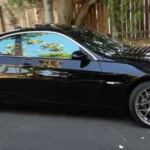Legal Window Tint in Nevada refers to the permissible level of darkness for tinted windows on vehicles within the state. As of the latest regulations, the allowable Visible Light Transmission (VLT) percentage for front side windows is 35%, while the rear and back windows can have a VLT of 20% or more.
What is the Legal Window Tint in Nevada? Discovering the acceptable tint levels is not only a matter of compliance but also a way to enhance your driving experience. With the right tint, you can protect yourself from the Nevada sun’s intense glare and reduce heat inside your vehicle.
After tinting, the front driver and passenger side windows should let more than 35% of the light into the vehicle.Any tint level can be used on the rear side windows and rear window.If the rear window is tinted, the vehicle must have two-way mirrors.Tints are limited by color. In Nevada, red and amber tints are illegal under state window tinting laws.
Importance of Complying with Regulations
Compliance with regulations is crucial, especially when it comes to legal window tint in Nevada. The state strictly mandates specific tint levels for vehicles to ensure road safety.
According to Nevada law, passenger vehicles must have a light transmittance of at least 35% for front side windows and any darkness can be used for rear windows. Failure to adhere to these regulations may result in fines and potential legal consequences.
Professionalism is key when addressing window tint regulations, including What Is Dyed Window Tint For Cars. It’s essential to provide exact information to clients, informing them of the legal requirements and potential repercussions of non-compliance.
Legal Consequences for Non-Compliance
In Nevada, legal consequences exist for non-compliance with window tint regulations. The permissible Visible Light Transmission (VLT) limit for front side windows is 35%, while rear side and rear windows can have any darkness. Violating these limits can result in fines ranging from $50 to $250, depending on the extent of non-compliance.
To ensure compliance, it’s crucial to note that medical exemptions are allowed with proper documentation. However, the exemption only applies to side windows, not the windshield. It’s essential to be aware of these regulations to avoid legal repercussions and fines. Always check and adhere to the specific tinting laws in Nevada to stay within the legal limits.
Factors Influencing Legal Window Tint
In Nevada, legal window tint is influenced by specific factors. The state law dictates that vehicles must have a minimum visible light transmission (VLT) of 35% on the front side windows. The rear and back side windows, however, can have any level of darkness. It’s crucial to adhere to these guidelines to avoid legal repercussions.
Factors affecting legal window tint include the type of vehicle and the specific windows in question. For instance, trucks and SUVs often have different regulations than standard cars. Understanding these factors is essential for ensuring compliance with Nevada’s window tint laws.
It’s recommended to check and confirm the VLT requirements for each window, as precise adherence to these regulations is necessary to avoid fines or legal issues related to window tinting.
Visible Light Transmission (VLT) Requirements
In Nevada, the legal requirements for Visible Light Transmission (VLT) on window tint are crucial. The law mandates that front side windows must allow over 35% VLT, while rear side and rear windows can have any darkness. This means the tint on the front side windows should transmit at least 35% of visible light.
To ensure compliance, it’s essential to understand these specifications. Any violation of these VLT requirements can result in penalties, emphasizing the importance of adhering to the law when tinting car windows in Nevada. Always check and follow these guidelines to avoid legal issues related to window tint darkness.
Medical Exemptions
In Nevada, medical exemptions for legal window tint exist. The law allows individuals with certain medical conditions to have tinted windows beyond the standard legal limits. This exemption is crucial for those who require additional protection from sunlight due to medical reasons, ensuring their comfort and well-being while complying with the state’s regulations.
To qualify for a medical exemption, individuals must provide proper documentation, such as a physician’s statement, detailing the medical necessity for increased window tinting. It’s essential to follow the prescribed procedures and provide accurate information to obtain this exemption legally.
Tips for Choosing Legal Window Tint
When selecting legal window tint in Nevada, consider the regulations set by the state. The permissible Visible Light Transmission (VLT) level for front side windows is 35%, while rear side and back windows can have any darkness. It’s crucial to adhere to these specifications to avoid legal consequences.
Keep in mind that reflective or mirrored tint is not allowed on any window, and the windshield should only have non-reflective tint on the topmost six inches. Following these guidelines ensures compliance with Nevada’s window tint laws, promoting both safety and legality for drivers in the state.
Working with Licensed Professionals
When considering legal window tint in Nevada, it’s crucial to work with licensed professionals. Licensed professionals ensure compliance with state regulations. The permissible VLT (Visible Light Transmission) levels for window tint in Nevada are 35% for front side windows and any darkness for rear windows.
For accurate information, consult the Nevada Revised Statutes (NRS) Title 43, Chapter 488. The collaboration with licensed experts guarantees adherence to the law and the avoidance of legal issues. Always prioritize professionalism and precision when dealing with window tinting to stay within the legal boundaries of the state.
Understanding Tint Certification Labels
When it comes to understanding tint certification labels for legal window tint in Nevada, clarity is crucial. The state of Nevada strictly regulates window tinting to ensure road safety. Certification labels, prominently displayed on tinted windows, indicate compliance with the legal standards set by the state.
These labels specify the acceptable levels of visible light transmission and serve as a quick reference for law enforcement. In Nevada, legal window tint percentages vary for different windows.
For sedans, the front side windows must allow at least 35% of light, while the back side and rear windows can have any darkness. SUVs and vans follow similar guidelines for the front side windows but allow any darkness for the back side and rear windows.
Enforcement and Penalties
In Nevada, legal window tint regulations are strictly enforced. The permissible Visible Light Transmission (VLT) limit for front side windows is 35%, while rear and back windows can have any darkness.
Penalties for violating these regulations include fines and potential removal of the illegal tint. Law enforcement actively monitors and enforces these standards to maintain road safety. Vehicle owners in Nevada must adhere to these regulations to avoid penalties.
The focus on strict enforcement ensures that drivers comply with the established VLT limits for window tinting, contributing to a safer driving environment. Being aware of and following these regulations helps drivers stay on the right side of the law and promotes a secure and lawful driving experience in the state.
Here’s a detailed table summarizing the information about legal window tint regulations in Nevada.
| Aspect | Regulation in Nevada |
| Front Side Windows VLT Limit | 35% |
| Rear and Back Windows VLT Limit | No specific limit; any darkness is allowed |
| Enforcement Approach | Actively monitored and strictly enforced by law enforcement |
| Penalties for Violation | Fines and potential removal of illegal tint |
| Purpose of Enforcement | Maintain road safety by ensuring compliance with VLT limits |
| Importance for Drivers | Adherence to regulations is crucial to avoid penalties and contribute to safer driving |
| Overall Objective | Create a secure and lawful driving environment in Nevada |
This table provides a clear and concise overview of the legal window tint regulations in Nevada, including specific VLT limits, enforcement measures, penalties for violation, and the overall importance of compliance.
FAQs
What are the VLT limits for front side windows in Nevada?
Front side windows in Nevada must have a Visible Light Transmission (VLT) limit of 35%.
Is there a specific VLT limit for rear and back windows in Nevada?
No, there is no specific VLT limit for rear and back windows in Nevada; any darkness is allowed.
How is the enforcement of legal window tint regulations in Nevada carried out?
Law enforcement actively monitors and strictly enforces legal window tint regulations to maintain road safety.
What penalties can be incurred for violating window tint regulations in Nevada?
Violations may result in fines and the potential removal of the illegal tint.
Why is it important for drivers in Nevada to adhere to window tint regulations?
Adherence to these regulations is crucial to avoid penalties and contributes to a safer and lawful driving environment.
Conclusion
Understanding and adhering to legal window tint regulations is essential for drivers in Nevada. With a front side window VLT limit of 35% and no specific limit for rear and back windows, it’s crucial to ensure compliance to avoid fines and potential removal of illegal tint.
Law enforcement actively monitors these regulations to maintain road safety, emphasizing the importance of drivers being aware and responsible. By following these guidelines, drivers contribute to creating a secure and lawful driving environment in the state. Stay informed, stay compliant, and prioritize safety on Nevada’s roads through proper window tint adherence.



